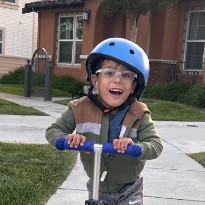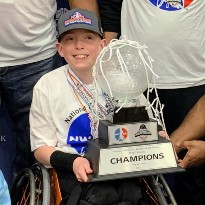The selective dorsal rhizotomy (SDR) recovery unit at TIRR Memorial Hermann provides specialized rehabilitation for cerebral palsy patients who have undergone SDR surgery. Guided by a multidisciplinary team, affiliated pediatric neurosurgeons and physical therapists, the unit focuses on comprehensive recovery for pediatric patients to maximize motor function and quality of life.
The level one laminectomy version of the procedure completed at Children’s Memorial Hermann Hospital, also known as a TS Park SDR, compared to multilevel laminectomy, is one of the most effective treatments for children with cerebral palsy who suffer from spastic diplegia or spastic hemiplegia. SDR selectively removes the abnormal stretch reflex that causes excessive muscle tone or tightness in the legs by carefully testing and cutting the nerve rootlets in the spinal cord. In addition to decreasing spasticity in the lower extremities, key goals of SDR surgery include preventing deformities and hip dislocations, improving tolerance for wearing orthotic devices, and reducing pain and discomfort associated with spasticity.
SDR Post-Operative Rehabilitation
Post-operative physical therapy is required for a successful SDR surgery journey. Patients undergoing SDR surgery at Children’s Memorial Hermann Hospital are typically up and moving the next day and receive one-on-one care from the hospital’s pediatric physical therapists. Normally, on the third day following surgery, post-operative rehabilitation continues at TIRR Memorial Hermann. It requires a strong commitment from every patient and their family. In the SDR recovery unit at TIRR Memorial Hermann, each patient receives a customized rehabilitation plan tailored to their specific needs to enhance long-term quality of life. Physical therapy plans vary by patient, with a typical recovery process outlined below.
Inpatient Rehabilitation
Intensive inpatient rehabilitation can last between three and six weeks. The schedule includes:
- Most children can sit up and begin physical therapy on the first day after surgery.
- Patients receive three to six hours of therapy daily, including physical therapy to improve movement and strength, occupational therapy to enhance daily living skills, as well as school and recreational activities.
- Therapy Focus:
- Improving muscle strength, control and coordination
- Locomotor training using bodyweight-supported treadmill training
- Functional electrical stimulation to stimulate muscles and enhance movement patterns
- Core and hip strengthening exercises
- Prone play for hip flexor stretching and promoting knee extension
- Improving posture and the ability to support weight
- Incorporating play and recreational activities to make therapy engaging and enjoyable for children
Post-Discharge Rehabilitation
Continued rehabilitation is crucial for long-term recovery. This phase involves:
- Initial Phase (from discharge to 12-week mark): Physical therapy three to five times per week
- Follow-Up Phase (from 12-week to 12-month mark): Physical therapy two to three times per week, focusing on maintaining progress and adapting to new movement patterns
- Home Exercise Program: Consistent daily exercises recommended by the therapy team
To ensure a safe and effective recovery following SDR surgery, several precautions are typically observed. These include specific movement restrictions such as avoiding vigorous rotations and stretching, postponing certain therapies like aquatic therapy, and focusing on foundational activities such as range of motion exercises. These precautions can vary for each patient based on their individual needs and recovery progress.
Benefits of the SDR Recovery Unit at TIRR Memorial Hermann
- Multidisciplinary Approach: The affiliated SDR recovery unit team includes pediatric neurosurgeons, physical therapists, occupational therapists, speech therapists, physical medicine and rehabilitation physicians, child life specialists, recreational therapists, school liaisons and case managers.
- Personalized, Comprehensive Care: Patients receive treatment from leading rehabilitation physicians, with personalized plans developed to meet specific recovery goals and needs.
- Advanced Facilities: Patients have access to state-of-the-art rehabilitation equipment and techniques, which are crucial for achieving the best possible outcomes.
Patient Stories
-
June 3, 2025
Zayn Gets the Chance to Chase His Dreams After Life-Changing Selective Dorsal Rhizotomy (SDR) Surgery for Cerebral Palsy
At 6 months of age and now home from the hospital, the twins were progressing at different rates. Zayn wasn’t sitting up or crawling like his brother Omar, who was steadily meeting his milestones. That’s when doctors diagnosed Zayn with spastic diplegia, a form of cerebral palsy that ...
-
August 7, 2024
Finley's Triumph: Selective Dorsal Rhizotomy Surgery
As Finley approached his teen years, he faced multiple procedures that profoundly impacted his life under the skilled care of Manish Shah, MD, a pediatric neurosurgeon affiliated with Children's Memorial Hermann Hospital and its Children’s Neuroscience Center. His journey through years of physica...
-
September 9, 2022
Defying the odds: Carlos’ story of courage, hope and resilience
Carlos’ intraventricular hemorrhage (neonatal brain bleed) led to scarring in his brain from being born prematurely. The severe scarring and lack of blood flow to his brain tissue contributed to periventricular leukomalacia (PVL), a softening of the white brain tissue near the fluid-f...
-
March 7, 2022
Himanshu’s Story: Novel Treatment for Hereditary Spastic Paraparesis
A novel treatment approach at Children’s Memorial Hermann Hospital is giving 17-year-old Himanshu Prasad the opportunity to live life free of the muscle tightness and spasticity that has plagued him since birth.
Contact Us
The selective dorsal rhizotomy recovery unit at TIRR Memorial Hermann is located within the Texas Medical Center.



